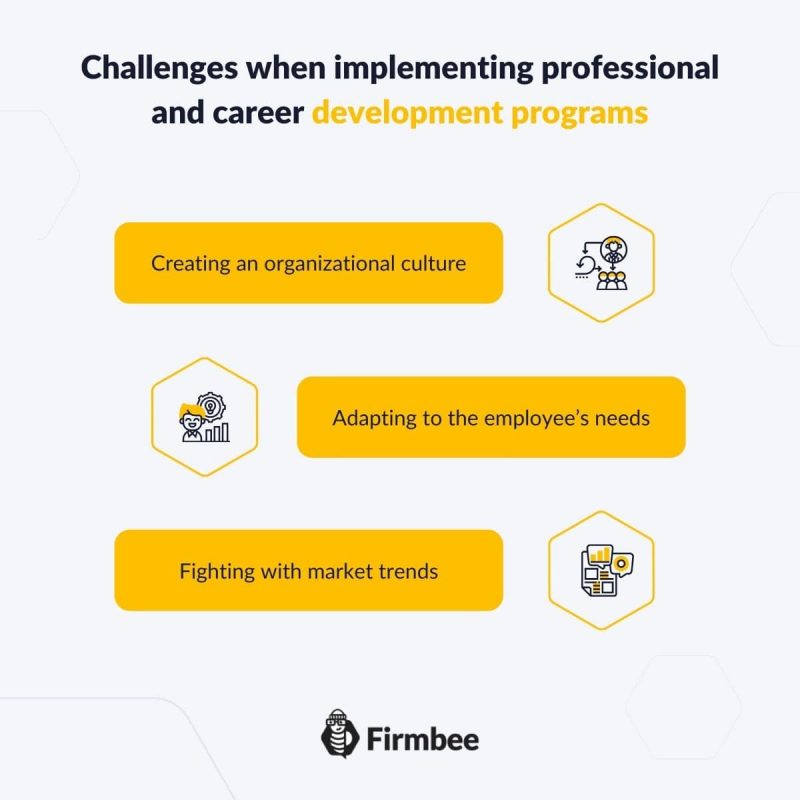Every HR department searches for employees who would add value to their organization and help in its development. Investing in employee training becomes profitable when a given employee starts from the lowest position in the company, then gets promoted to the next higher levels, and finally gets to the management team. Professional development programs are for sure well received by candidates since they give them hope for promotion. Their implementation, though, is associated with several challenges. Read on.
Implementing professional development programs – table of contents:
- Employee retention
- Employee development culture
- External courses vs. internal training
- Meeting employee needs
- Auditing professional development programs
- Summary
Employee retention
One of the main challenges when implementing career development programs is associated with trends that currently prevail on the job market. It has been claimed for some time that employees of generation Z and millenials will change their jobs at least once every three years.
Gone are the days when people worked in one place for their whole lives and enjoyed employment stability. The youngest generations, brought up in the times of globalization and access to the Internet, have the world at their fingertips, and changing jobs is a decicion made quickly and for a variety of reasons.
Professional development programs may become a factor that will help to retain empoyees – on the condition that thay are designed to support their development needs, which can be a great challenge to companies.
Employee development culture
The world is changing dynamically in the 21st century, which is, above all, associated with the growth of the Internet and other modern technologies along with a variety of software tools and digital solutions.
Organizations may not react to the changes happening on the market in their branches – passive behavior is equivalent to passing the baton to the competition. The same is true when it comes to employees.
Professional development should be a goal in itself, and this can only be achieved by a properly designed development culture, within which the internal professional development programs will function.
Creating effective learning experiences for employees should be supported by qualified coaches and the right tools (mentoring, coaching, training, job rotation, challenging assignments). It should be pointed out that it is much easier to create such an organizational culture when starting a business.
If you hire people from scratch, indicating that you care about their growth with the help of professional development programs , you will for sure find people willing to work under such conditions.
In case of older companies, where the same people have been working for years, changing the organizational culture – as any other modification carried out in the workplace – may encounter resistance due to ignorance, fear or misunderstanding. In such a situation, every effort should be made to obtain the desired employee attitude.

External courses vs. internal training
When talking about challenges related to implementing professional development programs in the workplace, one has to point out the strong competition from the external market.
The range of trainings and courses – both onsite and online, certified and non-certified, organized by domestic and foreign institutions – is currently so wide that it may lead to a situation when your employee will be more interested in the external, rather than in the internal offer.
Meeting employee needs
Professional development programs are created accordig to the company’s needs – the company cares about its growth in a particular direction, hiring employees specialized in specific areas and planning career paths aligned with its organizational vision.
On the one hand, such behaviour may be positively perceived by employees, but on the other hand, it might make them feel that they can’t develop in the way they want to. In the case of such a work environment, programs will encounter resistance due to the lack of individualization and responsiveness to the employee’s needs.
Finding a middle ground between the needs and requirements of both parties can prove to be quite challenging, which will force modifications in the program vision or changes in positions. This might become a significant problem especially for individuals with very diverse skills.
Once the candidate is hired for a job in a particular department (e.g., marketing) and the career development programs are in place, their extra skills might be overlooked. These skills could be better used in another department (e.g. HR). Switching career sectors is quite common these days, so doing it can kill confidence in capabilities other than those supported by the organization.
Auditing professional development programs
Implementing career development programs requires hiring qualified coaches and planning tools that will support their tasks. It is also necessary to develop plans that are tailored to the company’s needs and career paths for given positions. We can’t forget about auditing career development programs since organizational needs may also change.
Summary
Employee development and training is strategically important, especially in a dynamic world of change. Implementing appropriate programs responds to the company’s needs, but is associated with numerous challenges that the organization must face to achieve expected results. Creating an organizational culture, adapting to the employee’s needs and fighting with market trends are just a few of them.
If you like our content, join our busy bees community on Facebook, Twitter, LinkedIn, Instagram, YouTube.
Author: Nicole Mankin
HR manager with an excellent ability to build a positive atmosphere and create a valuable environment for employees. She loves to see the potential of talented people and mobilize them to develop.


















